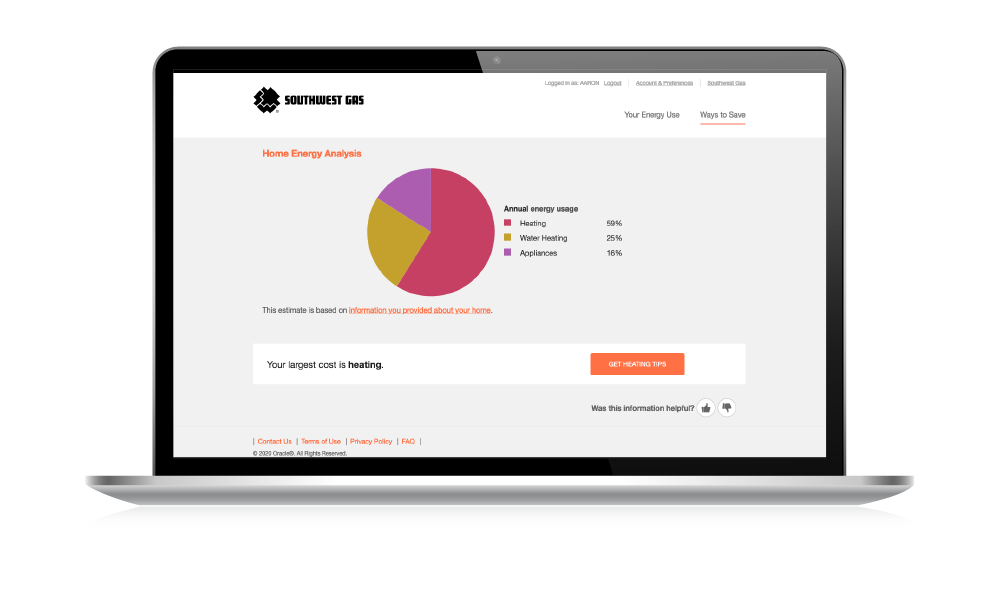Start being energy smart.
From the chill of winter to the swelter of summer, we help you prepare with smart energy saving tips.

Set your thermostat at 65-68 degrees Fahrenheit in the winter and 78-80 degrees Fahrenheit in the summer, health permitting.

Install a programmable thermostat and properly program it to follow your schedule.

Dress for the weather even when you’re inside. If it’s cold outside, dress in warm layers. When it’s hot, wear light, loose-fitting clothes.
Save Money & Energy
We're proud to be an
ENERGY STAR®
partner in our continued commitment to energy efficiency and conservation.
Learn all the ways you can save.

 Water Heating
Water Heating
- Optimize Your Water Heater Temperature
Set your water heater thermostat to the lowest temperature that still provides sufficient hot water. For most households, 120°F is comfortable and can save up to 22% of the energy spent on water heating annually. If your dishwasher allows, use 120°F water for optimal energy savings. Always follow the manufacturer’s directions.
- Upgrade to a More Efficient Water Heater
Water heating is one of your home's largest energy expenses. If your gas water heater is over 10 years old, consider replacing it with a newer model. New gas-powered demand water heaters, which heat water on demand without a storage tank, can be up to 34% more efficient than traditional storage water heaters. Also, look for a gas water heater with an Energy Factor (EF) rating of 0.62 or better.
- Reduce Hot Water Usage
Reducing hot water use lowers your natural gas and water bills. Install energy-efficient showerheads, which account for about 40% of a home’s hot water use. Reduce your shower time by just one minute to decrease water use by 13%. Use low-flow aerators on kitchen and bathroom faucets to cut hot water usage by up to 30% without losing water pressure. Always run full loads in your dishwasher and washing machine, and wash clothes in cold water whenever possible.
- Insulate and Maintain Your Water Heater
Insulate your older water heater to cut standby heat losses by 25-45% and reduce water heating costs by 7-16%. Specially designed water heater “jackets” can pay for themselves within a year. Additionally, when you’re away for several days, lower the temperature on your water heater or set it to “vacation mode” to save energy and money.

 Cooking & Appliances
Cooking & Appliances
- Cook Efficiently
Cooking accounts for about 5% of your home's energy use. Place lids tightly on pans to speed up cooking time and avoid preheating your gas oven unless necessary, such as for baking breads and cakes. For most other foods, preheating is unnecessary. By using a ceramic or glass dish for baking, you can typically set your oven for 25 degrees less than a recipe calls for. When possible, use energy-efficient appliances like microwaves, slow cookers, and toaster ovens instead of your full-sized oven. Cooking food in larger batches can also reduce energy use by utilizing your appliances less often.
- Choose Energy-Efficient Appliances
Investing in energy-efficient appliances when it’s time to upgrade can save you energy and money in the long run. Look for gas ovens, stoves, clothes dryers, and dishwashers that are ENERGY STAR® certified. Clothes dryers are particularly energy-intensive, so consider models with a moisture sensor that automatically shut off the machine when clothes are dry.
- Wash Clothes Efficiently
Washing clothes in cold water can reduce energy use, as 90% of the energy consumed for washing is used to heat the water. Unless your clothes have oily stains, cold or warm water will clean them just as effectively.
- Dry Clothes Efficiently
When using a clothes dryer, clean the lint filter before each use to maintain efficiency, and dry full, but not oversized, loads to maximize energy use. Avoid opening the door unnecessarily while it’s operating and use the no-heat cycle to plump pillows, refresh stored items, and remove lint or dust from drapes. Hang-drying laundry is an even more energy-efficient option and reduces wear and tear on your clothes.
- Optimize Dishwasher Use
Only run your dishwasher when it’s full and avoid rinsing dishes before loading them to save water and energy. Use the air-dry or no-heat drying option to further reduce energy use. An ENERGY STAR® dishwasher uses significantly less energy and water than washing dishes by hand.

 Home Heating & Cooling
Home Heating & Cooling
- Use a Programmable Thermostat Wisely
Install a programmable thermostat to automatically adjust your home’s temperature according to your schedule. Reducing the temperature by 7-10°F for eight hours a day when away can save up to 10% annually on heating costs in the winter. Remember to recycle your old mercury switch thermostat through the Thermostat Recycling Corporation (TRC) for safe disposal.
- Maintain Your Heating and Cooling System
Regular maintenance of your heating and cooling system is crucial for efficiency. Schedule a yearly tune-up with a licensed contractor and change or clean your air filter regularly—ideally every month during peak seasons and at least every three months. A dirty filter can increase energy consumption by up to 15% as your system works harder to circulate air.
- Seal Air Leaks and Insulate Properly
Air leaks around doors, windows, and vents can make your heating and cooling system work harder. Sealing these leaks can save up to 20% on your energy bills. Additionally, installing proper insulation, particularly around ducts and attics, can enhance your home’s energy efficiency.
- Optimize Fireplace Use
Fireplaces can lose more heat than they provide if not used wisely. Ensure to turn the fireplace off when you leave the room. Install glass doors and close the damper when the fireplace is not in use to prevent heat from escaping. If you use a fireplace regularly, consider upgrading to a high-efficiency natural gas insert or freestanding stove.
- Adjust Vents and Use Ceiling Fans
In a two-story home, adjusting upstairs vents can help manage the natural rise of warm air. In winter, reverse the direction of your ceiling fans to push warm air downwards, reducing reliance on your heating system.
- Utilize Sunlight and Window Treatments
During the winter, open blinds and curtains during the day to let in natural sunlight and help warm your home. In the summer, keep them closed to block out heat and reduce cooling costs. Consider adding window shades or films to further control the amount of heat entering your home.
- Cook Smart
Kitchens can generate excess heat while cooking. Use kitchen vents or fans to maintain a comfortable temperature.
- Use Efficient Heating Equipment
If your furnace is over 15 years old, upgrading to a high-efficiency model can reduce energy consumption and lower your heating bills. Look for ENERGY STAR® certified furnaces and boilers that provide optimal heating performance.
- Adjust Thermostat Gradually
During the summer, gradually increase your thermostat by 1°-2°F each week to allow your body to adjust, potentially cutting your cooling costs by up to 5%. Aim to set your thermostat at 78°F or higher when you’re at home, health permitting. In winter, consider using an electric blanket or mattress pad to stay warm at night, which uses far less energy than heating your entire home.

 Outdoor Living & Grilling
Outdoor Living & Grilling
- Choose Foods with Similar Cooking Times
When grilling, select foods that have comparable cooking times to reduce overall grilling time. Keep the grill lid closed as much as possible to maintain consistent heat and ensure efficient cooking.
- Grill Outdoors to Keep Your Kitchen Cool
Using your barbecue grill during the summer helps to keep your kitchen cool. This also cuts down on energy use, making your home more efficient. Always prioritize safety when grilling outdoors. Ensure your grill is in good working condition, keep it clean, and follow safety guidelines to prevent accidents. For detailed safety tips, refer to our Grilling Safety Tips section.
- Keep Your Pool or Spa Covered
Covering your pool or spa when not in use is one of the most effective ways to reduce energy consumption. A well-fitted cover minimizes nighttime heat loss, reduces water evaporation, and prevents chemical loss, which can save you 50-70% on pool heating costs.
- Maintain Your Pool Equipment
To keep your pool heating system and other equipment running efficiently, schedule regular inspection and deliming of the heat exchanger with your pool service technician. This routine maintenance ensures optimal performance, reduces energy use, and extends the life of your equipment.
- Reduce Pool Pump Run Time
Consider reducing the run time of your pool’s filtering and cleaning systems. Many pool owners find that running the pump for fewer hours still keeps the pool clean while saving up to 60% on energy costs. Most debris can be removed with a net or vacuum instead of running the pump daily.
- Lower Your Pool Temperature
Turning down the temperature on your pool heater can significantly reduce energy consumption. Even a small reduction in temperature can lead to substantial savings on your energy bills.
- Use Natural Gas Patio Heaters Efficiently
Natural gas patio heaters use radiant heat to warm objects rather than the surrounding air, making them an efficient choice for outdoor heating.
- Shelter Your Patio Heater
Wind can affect the efficiency of patio heaters. Consider installing your heater in a sheltered area, such as under eaves or along walls, while adhering to the manufacturer’s clearance requirements. This will help maintain consistent heat and reduce energy waste.

 Home Insulation, Windows & Ducts
Home Insulation, Windows & Ducts
- Choose Windows with a Low U-Value
A window's ability to insulate is determined by its U-value; the lower the U-value, the more efficient the window. Consider ENERGY STAR® qualified windows, which can help save up to 15% on your heating and cooling costs and look for energy-saving features like Low-E coating, double panes, and vinyl or fiberglass frames.
- Look for the NFRC Label
When selecting new windows, use the National Fenestration Rating Council (NFRC) label as your guide to window energy performance. This label provides essential information on the efficiency of the window, helping you make an informed choice.
- Improve Home Insulation
Improving the insulation in your home is one of the most effective ways to save energy. Proper insulation can reduce your home energy costs by an average of 11%, helping you stay warmer in the winter and cooler in the summer.
- Insulate and Seal Air Leaks
ENERGY STAR® estimates that sealing and insulating your home against air leaks can save up to 20% on heating and cooling costs. This includes insulating outlets and light switches, which are often overlooked but can contribute to heating or cooling loss.
- Seal and Insulate Your Attic
Sealing and insulating your attic is a critical step in improving your home's energy efficiency. Air sealing in the attic can be a challenging DIY project, but it offers substantial benefits. If you're not comfortable doing it yourself, consider hiring a licensed contractor.
- Test and Seal Leaky Ducts
Ducts can lose up to 30% of heated or cooled air before it reaches your living spaces if they are poorly sealed. Have your ducts professionally tested for leaks and seal them using mastic sealant or metal tape (not regular duct tape) to improve efficiency and reduce energy waste.
- Insulate Hot Water Pipes
Insulating your hot water pipes can save up to 4% annually on energy costs. This also means you won't have to wait as long for hot water, reducing energy use and increasing convenience.
- Add Heat-Shrink Film to Windows
If you have drafty single-pane windows and aren't ready to invest in new ones, consider using heat-shrink film. This plastic film creates a barrier against drafts and moisture, making your living space more comfortable and lowering heating costs.
- Maintain and Improve Ductwork
Sealing and insulating accessible ducts can significantly improve your heating and cooling system's performance. Contact a licensed contractor for maintenance, and regularly check for leaks to ensure that all ducts are properly insulated to minimize energy loss.
- Consider Window Upgrades
While replacing windows solely for energy savings may not always be cost-effective, the benefits of new windows go beyond efficiency. Upgraded windows offer improved comfort, security, noise reduction, and aesthetics, making them a worthwhile investment.
Energy Calculators

Find your carbon footprint bu using these energy calculators which can help you make more informed and energy efficient choices for your home or business.
Natural Gas 3X More Efficient
The carbon footprint of a natural gas home is much smaller than a similar home using electricity for heating and water heating. Visit
Home Energy Saver™ (HES)
to learn how reduce energy use in your homes.
ENERGY STAR® Homes

Your home is your castle, your haven, your place like no other. So why not invest in energy-efficient measures to get more value on your investment and lower energy bills in the long run? Make your home a star. An ENERGY STAR®.











 Rebates & Promotions
Rebates & Promotions











